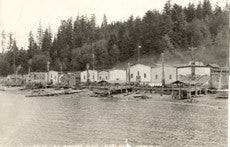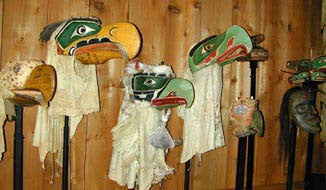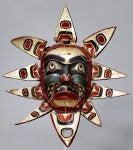The History of the Potlatch Collection
 Since 1922, some of our most treasured masks and ceremonial objects had been in the hands of museums in Canada, England and the United States, taken away at a time of great sorrow when a law deemed the potlatch was illegal. After years of effort, many of the confiscated treasures were successfully repatriated to their rightful owners, the Kwakwaka'wakw, and are now housed carefully in the U'mista Cultural Centre. This is called' The Potlatch Collection'.
Since 1922, some of our most treasured masks and ceremonial objects had been in the hands of museums in Canada, England and the United States, taken away at a time of great sorrow when a law deemed the potlatch was illegal. After years of effort, many of the confiscated treasures were successfully repatriated to their rightful owners, the Kwakwaka'wakw, and are now housed carefully in the U'mista Cultural Centre. This is called' The Potlatch Collection'.
Potlatch: a strict law bids us to dance
We dance to celebrate life, to show we are grateful for all our treasures. We must dance to show our history, since our history is always passed on in songs and dances. It is very important to tell the stories in exactly the same way. We put our stories into songs and into dances so they will not change. They will be told the same way every time. We use theatre and impressive masks to tell our ancestor’s adventures so the people witnessing the dance will remember it.
The ceremony to tell our stories and to show social changes such as birth, marriage, name giving, standing up a new chief and death is called a Potlatch. In the Chinook language it means ‘to give’. The people we invite are not only guests. They are also witnesses of our Potlatch and we give them presents for being a witness.
In the 1870's, two coastal entrepreneurs leased and pre-empted land on Cormorant Island for a fish saltery. They induced the ʼNa̱mǥis First Nation (Nimpkish Band) to move from their traditional village site on the Nimpkish River (Xwa̱lkw) to Alert Bay (ʼYa̱lis) to provide a source of labour for the saltery. Missionary Rev. Alfred Hall arrived and for the Indian's spiritual needs, built a church, for their educational needs, a school was built and for their further integration into the labour force, a saw mill. Land, commerce, church, education and with the arrival in the 1880's of an Indian agent, the final element - government administration - was added.
 As colonization had "progressed", the potlatch had changed as well. But as long as the potlatch continued, the civilizing mission of these forces was ineffectual. Their purpose was undermined, their authority threatened. The government may not have understood what the potlatch was, but knew very well what it stood for - the intactness of an Indian culture. For different reasons both whites and Indians agreed on one thing - the potlatch was the essence of Kwakwa̱ka̱ʼwakw culture. The opponents of the potlatch could only see the custom as a wasteful, immoral and heathen practice, an impediment in the road of progress. In 1883, pressure on the Federal Government by church and civil servants led to proclamation being issued, followed by legislation a year later on April 19, 1884 which amended the Indian Act to make engaging in the Potlatch a misdemeanor. The original law read:
As colonization had "progressed", the potlatch had changed as well. But as long as the potlatch continued, the civilizing mission of these forces was ineffectual. Their purpose was undermined, their authority threatened. The government may not have understood what the potlatch was, but knew very well what it stood for - the intactness of an Indian culture. For different reasons both whites and Indians agreed on one thing - the potlatch was the essence of Kwakwa̱ka̱ʼwakw culture. The opponents of the potlatch could only see the custom as a wasteful, immoral and heathen practice, an impediment in the road of progress. In 1883, pressure on the Federal Government by church and civil servants led to proclamation being issued, followed by legislation a year later on April 19, 1884 which amended the Indian Act to make engaging in the Potlatch a misdemeanor. The original law read:
- Every Indian or other person who engages in or assists in celebrating the Indian festival known as the "Potlatch" or the Indian dance known as the "Tamanawas" is guilty of a misdemeanor, and shall be liable to imprisonment for a term not more than six nor less than two months in a jail or other place of confinement.
- Any Indian or other person who encourages, either directly or indirectly an Indian or Indians to get up such a festival or dance, or to celebrate the same, or who shall assist in the celebration of same is guilty of a like offence, and shall be liable to the same punishment.
For some time, the law was virtually ignored, its wording was so vague as to make it meaningless in court and it proved difficult to enforce. The Kwakwa̱ka̱ʼwakw continued to potlatch until the law was revised and worded so carefully and all inclusive as to make even a guest at an Indian Christmas dinner liable to six months imprisonment. In 1921, Dan Cranmer hosted a big potlatch at Village Island (ʼMimkwa̱mlis). According to Dan Cranmer's recollection, the reasons for having the potlatch at Village Island were to avoid the Indian agent and that was where his wife's relatives were. Indian agent Halliday and Sgt. Angerman now had their chance to arrest and prosecute the Indians. Forty-five people were arrested and charged with various crimes, such as giving speeches, dancing, carrying and receiving gifts at the potlatch. Of those convicted of offences, twenty-two were given suspended sentences.
 The sentencing was based on the illegal agreement that, if entire tribes gave up their potlatch paraphernalia, individual members of those tribes who has been found guilty would have their sentences suspended. Three people were remanded for the appeal and twenty men and women were sent to Oakalla Prison near Vancouver, BC. to serve sentences of two months for the first offenders and three months for second offenders.
The sentencing was based on the illegal agreement that, if entire tribes gave up their potlatch paraphernalia, individual members of those tribes who has been found guilty would have their sentences suspended. Three people were remanded for the appeal and twenty men and women were sent to Oakalla Prison near Vancouver, BC. to serve sentences of two months for the first offenders and three months for second offenders.
Halliday arranged to store the confiscated goods in the Anglican Parish Hall at Alert Bay. For awhile, the goods were put on display there, and admission was charged. Halliday and other amateur photographers were able to add the masks to their album. Halliday sold 33 pieces to a collector, Mr. George Heye, of New York. Although Halliday "viewed his action" as consistent with the object of securing as much money as possible for the Indians. The department, however, responded immediately with a reprimand for Halliday's "unwarranted action".
The greater part of the collection was crated and shipped east and divided between the Victoria Memorial Museum, later the National Museum of Man and now the Canadian Museum of Civilization in Ottawa and the Royal Ontario Museum in Toronto. Duncan Campbell Scott, Deputy Superintendant of the Department of Indian Affairs, selected some of the pieces for his private collection. A few of the pieces ended up in the private collection of Sgt. Donald Angerman, of the B.C. Police, the arresting officer and prosecutor at the trials, later donated by B.E. Angerman in 1926 to the National Museum of the American Indian. In a letter dated October 9, 1922, to the curator of the Victoria Memorial Museum, Scott stated: "It is understood, of course, that these curios are to remain the property of the Dept. of Indian Affairs although housed in the Victoria Memorial Museum."
 For some years the potlatch went "underground" to evade further persecution. The Kwakwa̱ka̱ʼwakw continued to hope that the anti-potlatch law would be repealed. However, when the Indian Act was revised in 1951, Section 149 was simply deleted. In 1952 the first public potlatch was held in Victoria, BC hosted by Chief Mungo Martin. Since 1921, those who had lost their treasures had not forgotten their loss. The first real efforts to repatriate these objects were started in the late 1950's and early 1960's when Chief Jimmy Sewid and others began to work towards the return of our treasures through the respective band councils. A few years later, the Board of Trustees of the National Museums Corporation agreed to return that part of the Potlatch Collection held by the National Museum of Man. The return was conditional on the construction of a museum to properly house and care for the collection. During 1973 meetings and repatriation efforts were facilitated through the Kwakiutl District Council (KDC) and a meeting with Elders and representatives for the ʼNa̱mǥis Band and the Cape Mudge Band was held to discuss ownership and distribution of the artifacts. In 1974 the U'mista Cultural Society was incorporated and the question of the location of the building was resolved by having museums built in Cape Mudge and Alert Bay. By 1975, funding from the National Museums Assistance Program had been secured to assist with the construction of the U'mista Cultural Society's facility with monies for an operating fund to follow a month later. During this time the ʼNa̱mǥis Band and the Cape Mudge Band were continuing to work out the details of the division of the collection. Eventually the negotiations led to the decision that the oldest living descendants of the original owners to the artifacts were to decide where they wanted their treasures held.
For some years the potlatch went "underground" to evade further persecution. The Kwakwa̱ka̱ʼwakw continued to hope that the anti-potlatch law would be repealed. However, when the Indian Act was revised in 1951, Section 149 was simply deleted. In 1952 the first public potlatch was held in Victoria, BC hosted by Chief Mungo Martin. Since 1921, those who had lost their treasures had not forgotten their loss. The first real efforts to repatriate these objects were started in the late 1950's and early 1960's when Chief Jimmy Sewid and others began to work towards the return of our treasures through the respective band councils. A few years later, the Board of Trustees of the National Museums Corporation agreed to return that part of the Potlatch Collection held by the National Museum of Man. The return was conditional on the construction of a museum to properly house and care for the collection. During 1973 meetings and repatriation efforts were facilitated through the Kwakiutl District Council (KDC) and a meeting with Elders and representatives for the ʼNa̱mǥis Band and the Cape Mudge Band was held to discuss ownership and distribution of the artifacts. In 1974 the U'mista Cultural Society was incorporated and the question of the location of the building was resolved by having museums built in Cape Mudge and Alert Bay. By 1975, funding from the National Museums Assistance Program had been secured to assist with the construction of the U'mista Cultural Society's facility with monies for an operating fund to follow a month later. During this time the ʼNa̱mǥis Band and the Cape Mudge Band were continuing to work out the details of the division of the collection. Eventually the negotiations led to the decision that the oldest living descendants of the original owners to the artifacts were to decide where they wanted their treasures held.
 The Royal Ontario Museum was next to return those treasures which they held. Although the masks and regalia rightfully belonged to the Kwakwa̱ka̱ʼwakw it was not until 1988 that the ROM complied and returned their portions of the Potlatch Collection to the respective cultural centres. The negotiations with the National Museum of the American Indian progressed slowly until it was merged with the Smithsonian Institution and since then those objects sold to George Heye have come home.
The Royal Ontario Museum was next to return those treasures which they held. Although the masks and regalia rightfully belonged to the Kwakwa̱ka̱ʼwakw it was not until 1988 that the ROM complied and returned their portions of the Potlatch Collection to the respective cultural centres. The negotiations with the National Museum of the American Indian progressed slowly until it was merged with the Smithsonian Institution and since then those objects sold to George Heye have come home.
Negotiations continue for the remaining 24 artifacts. The last remaining artifact (a transformation mask NMAI catalogue number 11/5224) was transferred November 16, 1936 to the Cranmore Ethnographical Museum in Chislehurst, Kent, England. From there it was transferred to its current location, the British Museum. This mask is now on long-term loan at the U'mista Cultural Centre.
 In July of 2000 the Smithsonian Institute's National Museum of the American Indian Board of Trustees agreed to return another sixteen pieces from the Potlatch Collection still in New York. These artifacts were returned in 2002 and are now on display here at the U'mista.
In July of 2000 the Smithsonian Institute's National Museum of the American Indian Board of Trustees agreed to return another sixteen pieces from the Potlatch Collection still in New York. These artifacts were returned in 2002 and are now on display here at the U'mista.
However, there are an undetermined number of objects whose whereabouts are unknown. The U'mista Cultural Society will continue to seek the repatriation of those objects when they are located.
For more information please contact us.
